SNGP3004: Automated Drug Dispensing System Reduces Medication Error
VerifiedAdded on 2023/04/11
|23
|4878
|375
Literature Review
AI Summary
This systematic review investigates the impact of automated drug dispensing systems on reducing medication errors in healthcare settings. The review synthesizes recent literature, focusing on the cost-effectiveness, improved medication administration quality, and overall efficiency of these systems. A search strategy across CINAHL, PubMed, and Medline databases identified six relevant research articles, which were then analyzed using thematic analysis. Key findings highlight that automated drug dispensing systems significantly decrease medication errors, ensure accurate dosage calculation, and enhance patient safety. The review concludes that implementing these systems can effectively lower healthcare costs and improve the quality of patient care by reducing errors and improving medication adherence.

Running head: JOURNAL MANUSCRIPT ASSIGNMENT
AUTOMATED DRUG DISPENSING SYSTEM REDUCED THE RATE OF
MEDICATION ERROR
Abstract
Aim
The aim of this systematic review is to be identifying recent literature articles to
understand the beneficial effect of applying automated drug dispensing system in the
healthcare settings.
Design
The systematic review includes an integrative review process in which all the recent
literatures has been collected and a relevant review has been conducted to conduct a rigorous
analysis.
Intervention
Search strategy was conducted with collecting literatures from three databases and
then selecting 6 research articles so that a systematic analysis could be conducted and these
interventions could be used to establish the effectiveness of automated drug dispensing
system.
Main outcome
This review was able to cover all the aspects related to the application of drug
distribution system to reduce the rate of medication error in healthcare facilities. All the
findings indicated to the fact that cost effectiveness of the automated drug dispensing
machine, its ability to increase the quality of medication administration and cost effectiveness
are the primary aspects that makes the healthcare facilities to implement this system.
Conclusion
Inclusion of drug dispensing system effectively decreases the high cost of healthcare
facilities and in cost effective manner helps to provide the patients with effective and quality
healthcare interventions.
Key words
Automated drug dispensing system, medication error, effectiveness, patient safety,
efficiency.
AUTOMATED DRUG DISPENSING SYSTEM REDUCED THE RATE OF
MEDICATION ERROR
Abstract
Aim
The aim of this systematic review is to be identifying recent literature articles to
understand the beneficial effect of applying automated drug dispensing system in the
healthcare settings.
Design
The systematic review includes an integrative review process in which all the recent
literatures has been collected and a relevant review has been conducted to conduct a rigorous
analysis.
Intervention
Search strategy was conducted with collecting literatures from three databases and
then selecting 6 research articles so that a systematic analysis could be conducted and these
interventions could be used to establish the effectiveness of automated drug dispensing
system.
Main outcome
This review was able to cover all the aspects related to the application of drug
distribution system to reduce the rate of medication error in healthcare facilities. All the
findings indicated to the fact that cost effectiveness of the automated drug dispensing
machine, its ability to increase the quality of medication administration and cost effectiveness
are the primary aspects that makes the healthcare facilities to implement this system.
Conclusion
Inclusion of drug dispensing system effectively decreases the high cost of healthcare
facilities and in cost effective manner helps to provide the patients with effective and quality
healthcare interventions.
Key words
Automated drug dispensing system, medication error, effectiveness, patient safety,
efficiency.
Paraphrase This Document
Need a fresh take? Get an instant paraphrase of this document with our AI Paraphraser
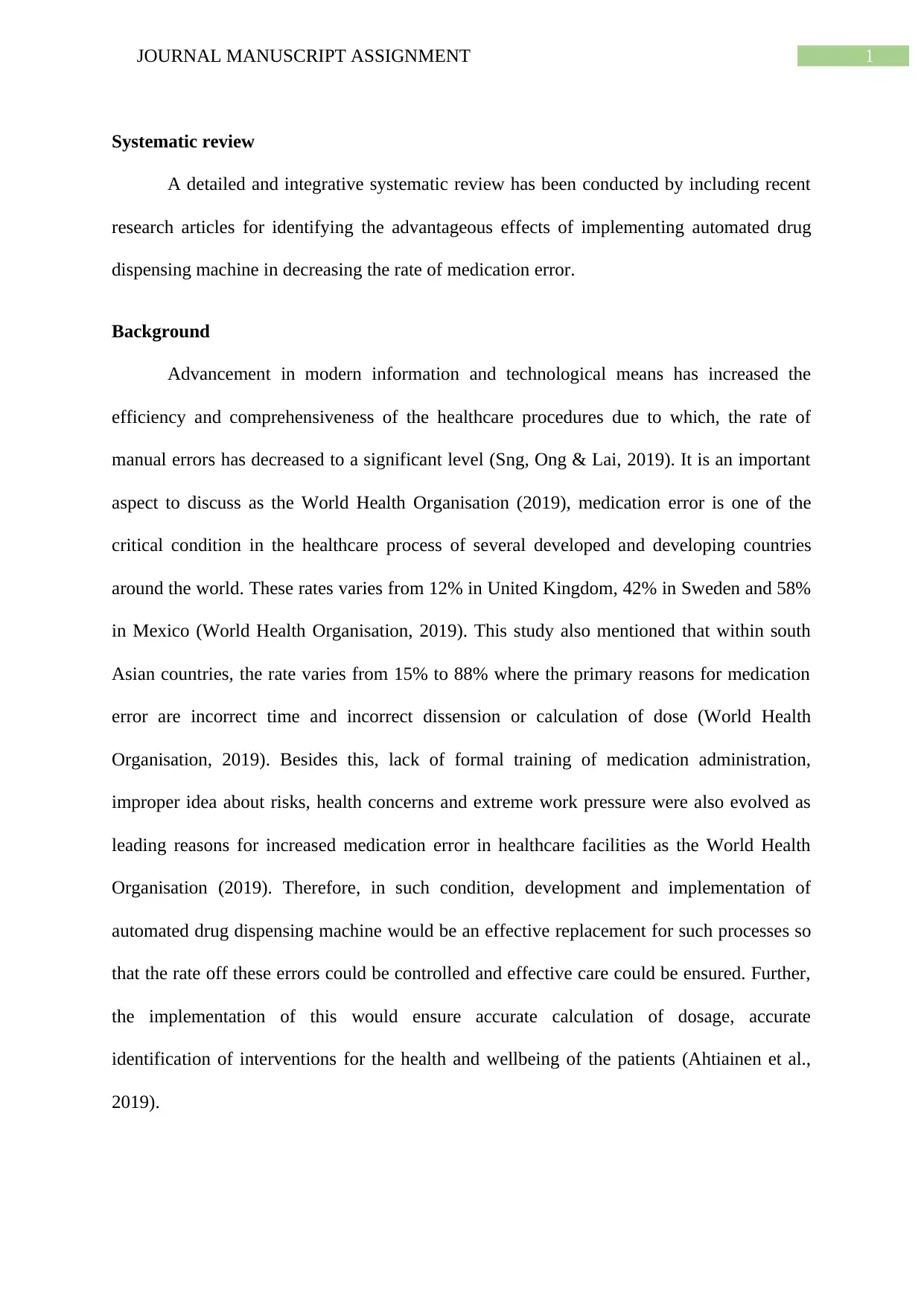
1JOURNAL MANUSCRIPT ASSIGNMENT
Systematic review
A detailed and integrative systematic review has been conducted by including recent
research articles for identifying the advantageous effects of implementing automated drug
dispensing machine in decreasing the rate of medication error.
Background
Advancement in modern information and technological means has increased the
efficiency and comprehensiveness of the healthcare procedures due to which, the rate of
manual errors has decreased to a significant level (Sng, Ong & Lai, 2019). It is an important
aspect to discuss as the World Health Organisation (2019), medication error is one of the
critical condition in the healthcare process of several developed and developing countries
around the world. These rates varies from 12% in United Kingdom, 42% in Sweden and 58%
in Mexico (World Health Organisation, 2019). This study also mentioned that within south
Asian countries, the rate varies from 15% to 88% where the primary reasons for medication
error are incorrect time and incorrect dissension or calculation of dose (World Health
Organisation, 2019). Besides this, lack of formal training of medication administration,
improper idea about risks, health concerns and extreme work pressure were also evolved as
leading reasons for increased medication error in healthcare facilities as the World Health
Organisation (2019). Therefore, in such condition, development and implementation of
automated drug dispensing machine would be an effective replacement for such processes so
that the rate off these errors could be controlled and effective care could be ensured. Further,
the implementation of this would ensure accurate calculation of dosage, accurate
identification of interventions for the health and wellbeing of the patients (Ahtiainen et al.,
2019).
Systematic review
A detailed and integrative systematic review has been conducted by including recent
research articles for identifying the advantageous effects of implementing automated drug
dispensing machine in decreasing the rate of medication error.
Background
Advancement in modern information and technological means has increased the
efficiency and comprehensiveness of the healthcare procedures due to which, the rate of
manual errors has decreased to a significant level (Sng, Ong & Lai, 2019). It is an important
aspect to discuss as the World Health Organisation (2019), medication error is one of the
critical condition in the healthcare process of several developed and developing countries
around the world. These rates varies from 12% in United Kingdom, 42% in Sweden and 58%
in Mexico (World Health Organisation, 2019). This study also mentioned that within south
Asian countries, the rate varies from 15% to 88% where the primary reasons for medication
error are incorrect time and incorrect dissension or calculation of dose (World Health
Organisation, 2019). Besides this, lack of formal training of medication administration,
improper idea about risks, health concerns and extreme work pressure were also evolved as
leading reasons for increased medication error in healthcare facilities as the World Health
Organisation (2019). Therefore, in such condition, development and implementation of
automated drug dispensing machine would be an effective replacement for such processes so
that the rate off these errors could be controlled and effective care could be ensured. Further,
the implementation of this would ensure accurate calculation of dosage, accurate
identification of interventions for the health and wellbeing of the patients (Ahtiainen et al.,
2019).
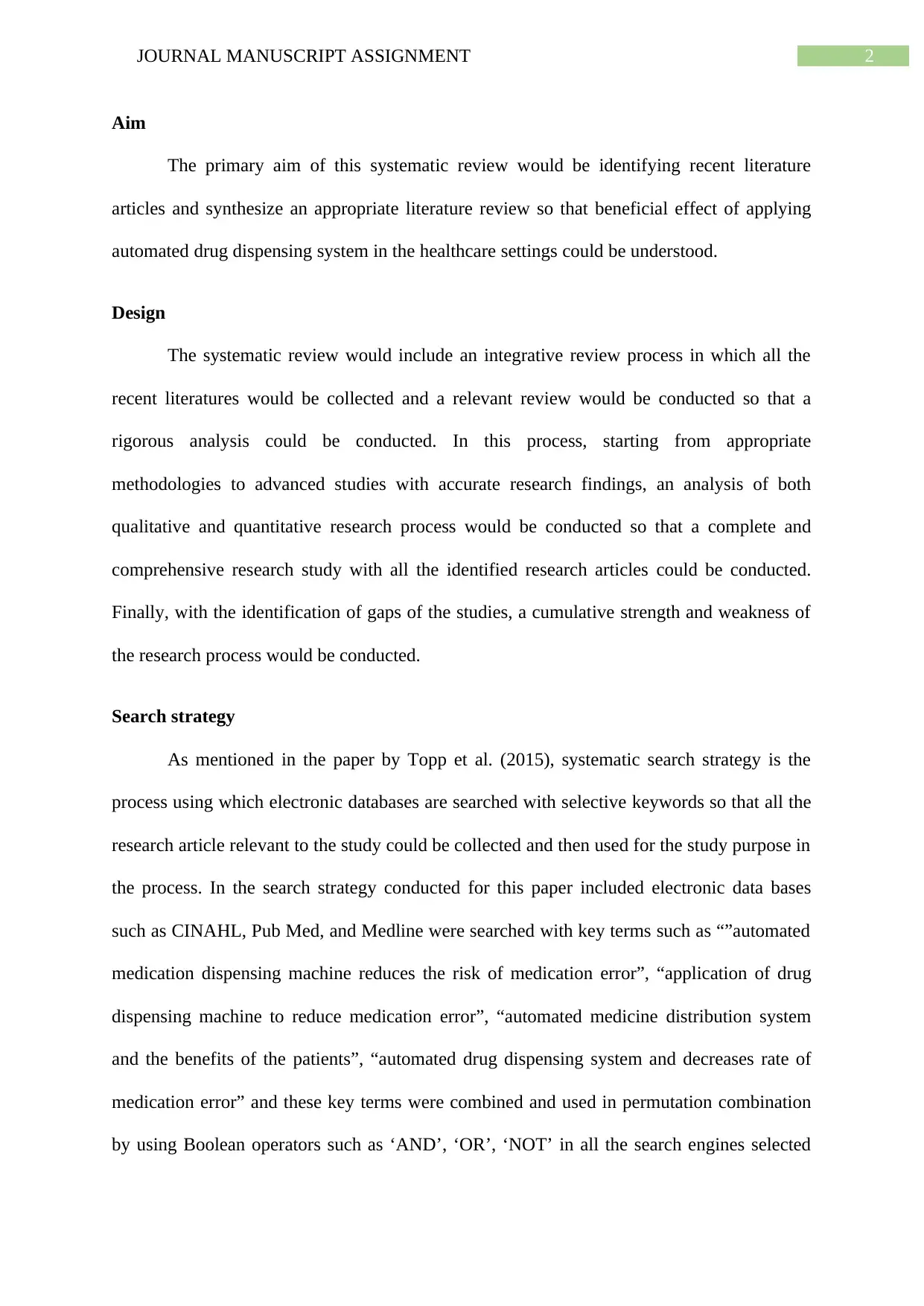
2JOURNAL MANUSCRIPT ASSIGNMENT
Aim
The primary aim of this systematic review would be identifying recent literature
articles and synthesize an appropriate literature review so that beneficial effect of applying
automated drug dispensing system in the healthcare settings could be understood.
Design
The systematic review would include an integrative review process in which all the
recent literatures would be collected and a relevant review would be conducted so that a
rigorous analysis could be conducted. In this process, starting from appropriate
methodologies to advanced studies with accurate research findings, an analysis of both
qualitative and quantitative research process would be conducted so that a complete and
comprehensive research study with all the identified research articles could be conducted.
Finally, with the identification of gaps of the studies, a cumulative strength and weakness of
the research process would be conducted.
Search strategy
As mentioned in the paper by Topp et al. (2015), systematic search strategy is the
process using which electronic databases are searched with selective keywords so that all the
research article relevant to the study could be collected and then used for the study purpose in
the process. In the search strategy conducted for this paper included electronic data bases
such as CINAHL, Pub Med, and Medline were searched with key terms such as “”automated
medication dispensing machine reduces the risk of medication error”, “application of drug
dispensing machine to reduce medication error”, “automated medicine distribution system
and the benefits of the patients”, “automated drug dispensing system and decreases rate of
medication error” and these key terms were combined and used in permutation combination
by using Boolean operators such as ‘AND’, ‘OR’, ‘NOT’ in all the search engines selected
Aim
The primary aim of this systematic review would be identifying recent literature
articles and synthesize an appropriate literature review so that beneficial effect of applying
automated drug dispensing system in the healthcare settings could be understood.
Design
The systematic review would include an integrative review process in which all the
recent literatures would be collected and a relevant review would be conducted so that a
rigorous analysis could be conducted. In this process, starting from appropriate
methodologies to advanced studies with accurate research findings, an analysis of both
qualitative and quantitative research process would be conducted so that a complete and
comprehensive research study with all the identified research articles could be conducted.
Finally, with the identification of gaps of the studies, a cumulative strength and weakness of
the research process would be conducted.
Search strategy
As mentioned in the paper by Topp et al. (2015), systematic search strategy is the
process using which electronic databases are searched with selective keywords so that all the
research article relevant to the study could be collected and then used for the study purpose in
the process. In the search strategy conducted for this paper included electronic data bases
such as CINAHL, Pub Med, and Medline were searched with key terms such as “”automated
medication dispensing machine reduces the risk of medication error”, “application of drug
dispensing machine to reduce medication error”, “automated medicine distribution system
and the benefits of the patients”, “automated drug dispensing system and decreases rate of
medication error” and these key terms were combined and used in permutation combination
by using Boolean operators such as ‘AND’, ‘OR’, ‘NOT’ in all the search engines selected
⊘ This is a preview!⊘
Do you want full access?
Subscribe today to unlock all pages.

Trusted by 1+ million students worldwide

3JOURNAL MANUSCRIPT ASSIGNMENT
for the study. As the automated drug dispensing machine is developed and used in recent
times, the search time limit selected for this paper was 2012 to 2019 so that all the relevant
research papers could be collected. The inclusion criteria that were selected for the paper
were presences of English language, complete research article on the other hand, the
exclusion criteria of the paper would be language other than English and research articles that
are not accessible and hence, a relevant and appropriate research would be conducted.
Search outcome
The search outcome would include all the research journals that matches with the
inclusion criteria of the paper and then by applying the inclusion and exclusion criteria,
stating from the tile of the study to the abstract and research methodology, all important
aspects of the papers were assessed. The search flowchart that were used to select the
research articles in the paper is as follows:
for the study. As the automated drug dispensing machine is developed and used in recent
times, the search time limit selected for this paper was 2012 to 2019 so that all the relevant
research papers could be collected. The inclusion criteria that were selected for the paper
were presences of English language, complete research article on the other hand, the
exclusion criteria of the paper would be language other than English and research articles that
are not accessible and hence, a relevant and appropriate research would be conducted.
Search outcome
The search outcome would include all the research journals that matches with the
inclusion criteria of the paper and then by applying the inclusion and exclusion criteria,
stating from the tile of the study to the abstract and research methodology, all important
aspects of the papers were assessed. The search flowchart that were used to select the
research articles in the paper is as follows:
Paraphrase This Document
Need a fresh take? Get an instant paraphrase of this document with our AI Paraphraser
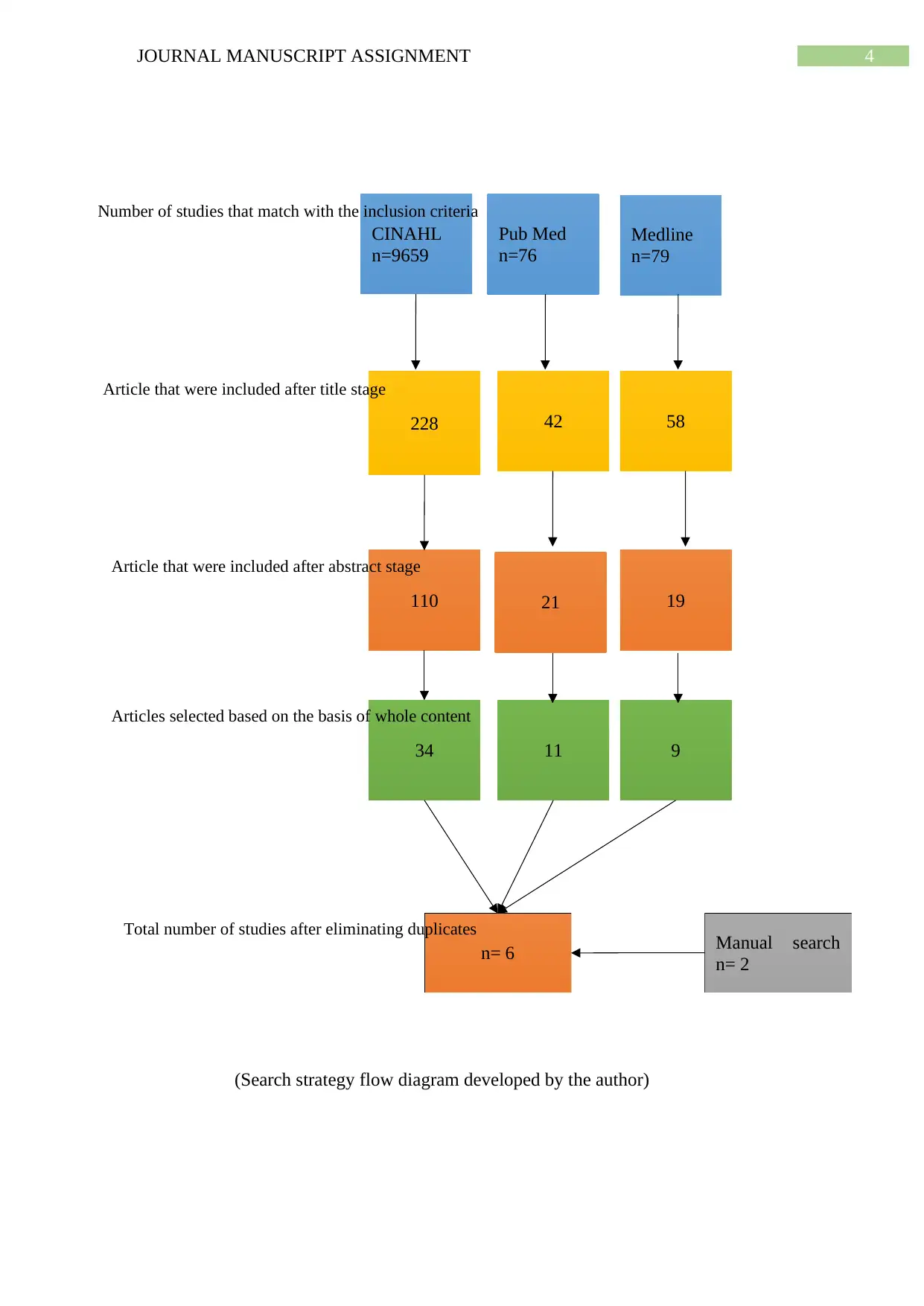
4JOURNAL MANUSCRIPT ASSIGNMENT
Medline
n=79
Pub Med
n=76
CINAHL
n=9659
228 42 58
110 21 19
91134
Number of studies that match with the inclusion criteria
Article that were included after title stage
Article that were included after abstract stage
Articles selected based on the basis of whole content
n= 6 Manual search
n= 2
Total number of studies after eliminating duplicates
(Search strategy flow diagram developed by the author)
Medline
n=79
Pub Med
n=76
CINAHL
n=9659
228 42 58
110 21 19
91134
Number of studies that match with the inclusion criteria
Article that were included after title stage
Article that were included after abstract stage
Articles selected based on the basis of whole content
n= 6 Manual search
n= 2
Total number of studies after eliminating duplicates
(Search strategy flow diagram developed by the author)

5JOURNAL MANUSCRIPT ASSIGNMENT
Quality appraisal
In this paper, the quality appraisal process was conducted with all the 6 research
articles included in the paper as Zeng et al. (2015) mentioned it as an important step for the
enhancement of the quality of the journal. The Critical Appraisal Skills Programme or CASP
tools were used to conduct the quality appraisal of the research articles with qualitative
research aspect, whereas for the quantitative research process, Center for Evidence-Based
Management critical appraisal tool were used so that all the positive and negative aspects of
these included research studies that could affect the findings of the paper could be mentioned.
Data abstraction and synthesis
In this journal manuscript paper, all the articles were tabulated and then from each of
these papers important definitions and key words, depending on which the entire paper
revolved were used. As per Liñán and Fayolle (2015), these helped to determine the thematic
analysis of the paper and with this, the iterative comparison between the papers were
conducted. Besides this, with thematic analysis it was a possible to accumulate the papers that
could be collectively used for one thematic analysis and hence relativity and accuracy of the
research study was ensured. In the appendix section of this paper, the tabular information of
each of the article has been included.
Findings
Overview of the studies included
All the six research articles that were included for the review in this paper were
evaluated depending upon their research methodology and research findings and the
summary of this quality appraisal has been provided in the appendix section of this paper. In
these papers, 3 papers followed the non-randomized control study, whereas 2 studies
followed the before and after observational study. The final paper that was included in the
Quality appraisal
In this paper, the quality appraisal process was conducted with all the 6 research
articles included in the paper as Zeng et al. (2015) mentioned it as an important step for the
enhancement of the quality of the journal. The Critical Appraisal Skills Programme or CASP
tools were used to conduct the quality appraisal of the research articles with qualitative
research aspect, whereas for the quantitative research process, Center for Evidence-Based
Management critical appraisal tool were used so that all the positive and negative aspects of
these included research studies that could affect the findings of the paper could be mentioned.
Data abstraction and synthesis
In this journal manuscript paper, all the articles were tabulated and then from each of
these papers important definitions and key words, depending on which the entire paper
revolved were used. As per Liñán and Fayolle (2015), these helped to determine the thematic
analysis of the paper and with this, the iterative comparison between the papers were
conducted. Besides this, with thematic analysis it was a possible to accumulate the papers that
could be collectively used for one thematic analysis and hence relativity and accuracy of the
research study was ensured. In the appendix section of this paper, the tabular information of
each of the article has been included.
Findings
Overview of the studies included
All the six research articles that were included for the review in this paper were
evaluated depending upon their research methodology and research findings and the
summary of this quality appraisal has been provided in the appendix section of this paper. In
these papers, 3 papers followed the non-randomized control study, whereas 2 studies
followed the before and after observational study. The final paper that was included in the
⊘ This is a preview!⊘
Do you want full access?
Subscribe today to unlock all pages.

Trusted by 1+ million students worldwide

6JOURNAL MANUSCRIPT ASSIGNMENT
paper was a descriptive narrative of the literature review depending upon which, the study
was conducted. Further, these six studies were conducted n countries such as Australia (1),
Denmark (2), the United Kingdom (1), France (1), and the United States of America (1).
Within these research articles, three article by Risør, Lisby and Sørensen (2016), Weant,
Bailey and Baker (2014) and Cusein et al. (2014) discussed about the impact of the
automated drug distribution system of the accuracy, effectiveness and impact on the
healthcare process, and the way the drug dispensing machine helps to reduce the medication
error in healthcare facilities. the other two research article by Fanning, Jones and Manias
(2016) and Cottney(2014) respectively tried to understand the positive and negative impact of
drug dispensing system on the healthcare facilities and the way the healthcare outcome is
improved after using such system in the healthcare facilities. The final paper by Risør, Lisby
and Sørensen(2017) aimed to assess the cost effectiveness of using drug dispensing machine
with decreased medication error. While determining the themes of the papers included in the
discussion analysed three primary themes such as decreased medication error and accurate
medication proportion, cost effectiveness of the drug dispensing machine, and the drug
dispensing machine and increased quality of medication administration. The entire 6
research article selected for this paper analysis would be analysed on the basis of these three
themes so that effectiveness of the automated drug dispensing machine on decreased drug
dispensing machine could be understood.
Decreased medication error and accurate medication proportion
Decreased rate of medication error and increased adherence to the medication has
been emerged as the primary theme of majority of the research articles that has been
conducted research to analyse the effectiveness of the automated drug dispensing machine in
decreasing the medication error in patients. The research article by Fanning, Jones and
Manias (2016), was conducted with similar aim and their goal was to analyse the role of
paper was a descriptive narrative of the literature review depending upon which, the study
was conducted. Further, these six studies were conducted n countries such as Australia (1),
Denmark (2), the United Kingdom (1), France (1), and the United States of America (1).
Within these research articles, three article by Risør, Lisby and Sørensen (2016), Weant,
Bailey and Baker (2014) and Cusein et al. (2014) discussed about the impact of the
automated drug distribution system of the accuracy, effectiveness and impact on the
healthcare process, and the way the drug dispensing machine helps to reduce the medication
error in healthcare facilities. the other two research article by Fanning, Jones and Manias
(2016) and Cottney(2014) respectively tried to understand the positive and negative impact of
drug dispensing system on the healthcare facilities and the way the healthcare outcome is
improved after using such system in the healthcare facilities. The final paper by Risør, Lisby
and Sørensen(2017) aimed to assess the cost effectiveness of using drug dispensing machine
with decreased medication error. While determining the themes of the papers included in the
discussion analysed three primary themes such as decreased medication error and accurate
medication proportion, cost effectiveness of the drug dispensing machine, and the drug
dispensing machine and increased quality of medication administration. The entire 6
research article selected for this paper analysis would be analysed on the basis of these three
themes so that effectiveness of the automated drug dispensing machine on decreased drug
dispensing machine could be understood.
Decreased medication error and accurate medication proportion
Decreased rate of medication error and increased adherence to the medication has
been emerged as the primary theme of majority of the research articles that has been
conducted research to analyse the effectiveness of the automated drug dispensing machine in
decreasing the medication error in patients. The research article by Fanning, Jones and
Manias (2016), was conducted with similar aim and their goal was to analyse the role of
Paraphrase This Document
Need a fresh take? Get an instant paraphrase of this document with our AI Paraphraser
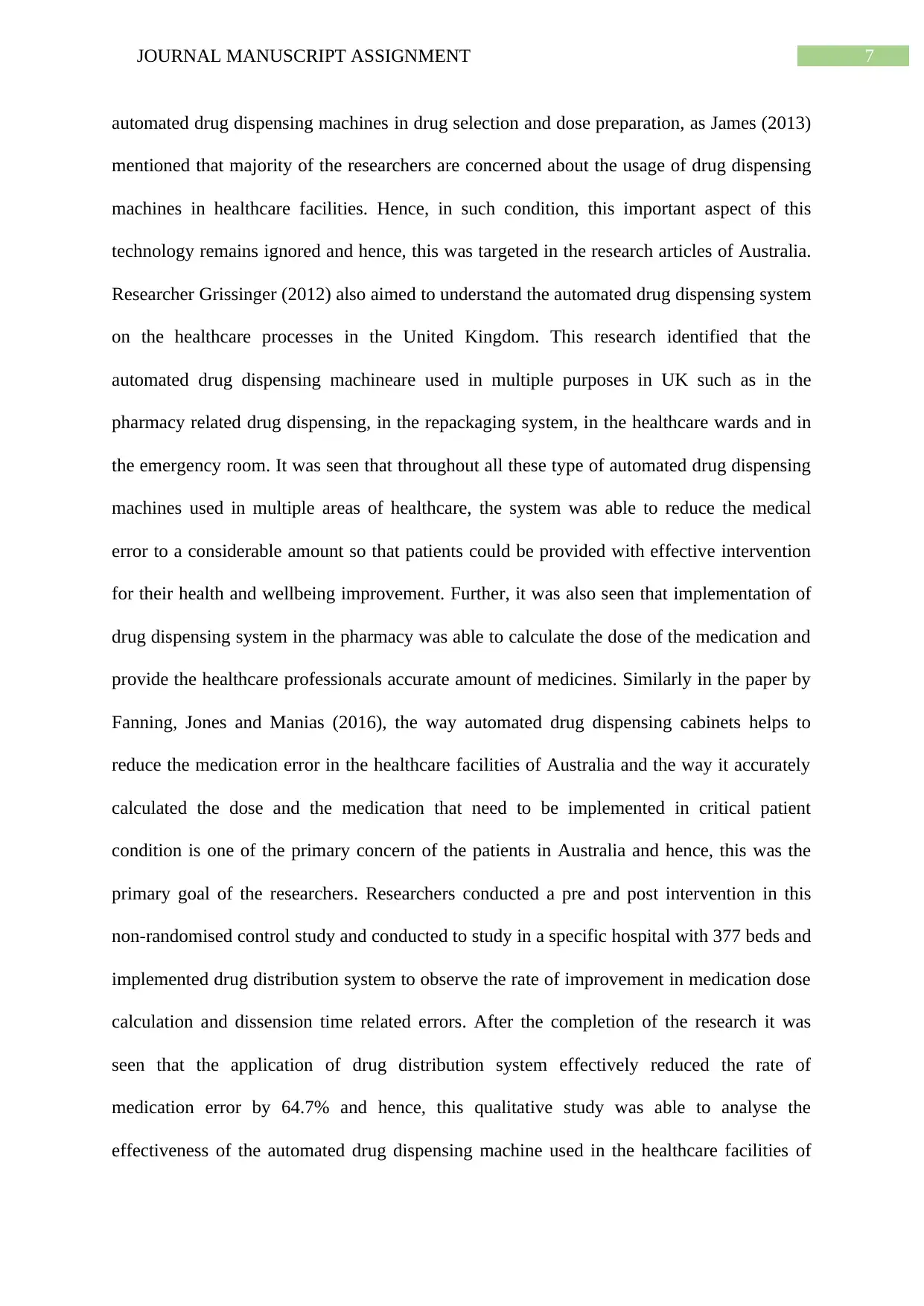
7JOURNAL MANUSCRIPT ASSIGNMENT
automated drug dispensing machines in drug selection and dose preparation, as James (2013)
mentioned that majority of the researchers are concerned about the usage of drug dispensing
machines in healthcare facilities. Hence, in such condition, this important aspect of this
technology remains ignored and hence, this was targeted in the research articles of Australia.
Researcher Grissinger (2012) also aimed to understand the automated drug dispensing system
on the healthcare processes in the United Kingdom. This research identified that the
automated drug dispensing machineare used in multiple purposes in UK such as in the
pharmacy related drug dispensing, in the repackaging system, in the healthcare wards and in
the emergency room. It was seen that throughout all these type of automated drug dispensing
machines used in multiple areas of healthcare, the system was able to reduce the medical
error to a considerable amount so that patients could be provided with effective intervention
for their health and wellbeing improvement. Further, it was also seen that implementation of
drug dispensing system in the pharmacy was able to calculate the dose of the medication and
provide the healthcare professionals accurate amount of medicines. Similarly in the paper by
Fanning, Jones and Manias (2016), the way automated drug dispensing cabinets helps to
reduce the medication error in the healthcare facilities of Australia and the way it accurately
calculated the dose and the medication that need to be implemented in critical patient
condition is one of the primary concern of the patients in Australia and hence, this was the
primary goal of the researchers. Researchers conducted a pre and post intervention in this
non-randomised control study and conducted to study in a specific hospital with 377 beds and
implemented drug distribution system to observe the rate of improvement in medication dose
calculation and dissension time related errors. After the completion of the research it was
seen that the application of drug distribution system effectively reduced the rate of
medication error by 64.7% and hence, this qualitative study was able to analyse the
effectiveness of the automated drug dispensing machine used in the healthcare facilities of
automated drug dispensing machines in drug selection and dose preparation, as James (2013)
mentioned that majority of the researchers are concerned about the usage of drug dispensing
machines in healthcare facilities. Hence, in such condition, this important aspect of this
technology remains ignored and hence, this was targeted in the research articles of Australia.
Researcher Grissinger (2012) also aimed to understand the automated drug dispensing system
on the healthcare processes in the United Kingdom. This research identified that the
automated drug dispensing machineare used in multiple purposes in UK such as in the
pharmacy related drug dispensing, in the repackaging system, in the healthcare wards and in
the emergency room. It was seen that throughout all these type of automated drug dispensing
machines used in multiple areas of healthcare, the system was able to reduce the medical
error to a considerable amount so that patients could be provided with effective intervention
for their health and wellbeing improvement. Further, it was also seen that implementation of
drug dispensing system in the pharmacy was able to calculate the dose of the medication and
provide the healthcare professionals accurate amount of medicines. Similarly in the paper by
Fanning, Jones and Manias (2016), the way automated drug dispensing cabinets helps to
reduce the medication error in the healthcare facilities of Australia and the way it accurately
calculated the dose and the medication that need to be implemented in critical patient
condition is one of the primary concern of the patients in Australia and hence, this was the
primary goal of the researchers. Researchers conducted a pre and post intervention in this
non-randomised control study and conducted to study in a specific hospital with 377 beds and
implemented drug distribution system to observe the rate of improvement in medication dose
calculation and dissension time related errors. After the completion of the research it was
seen that the application of drug distribution system effectively reduced the rate of
medication error by 64.7% and hence, this qualitative study was able to analyse the
effectiveness of the automated drug dispensing machine used in the healthcare facilities of
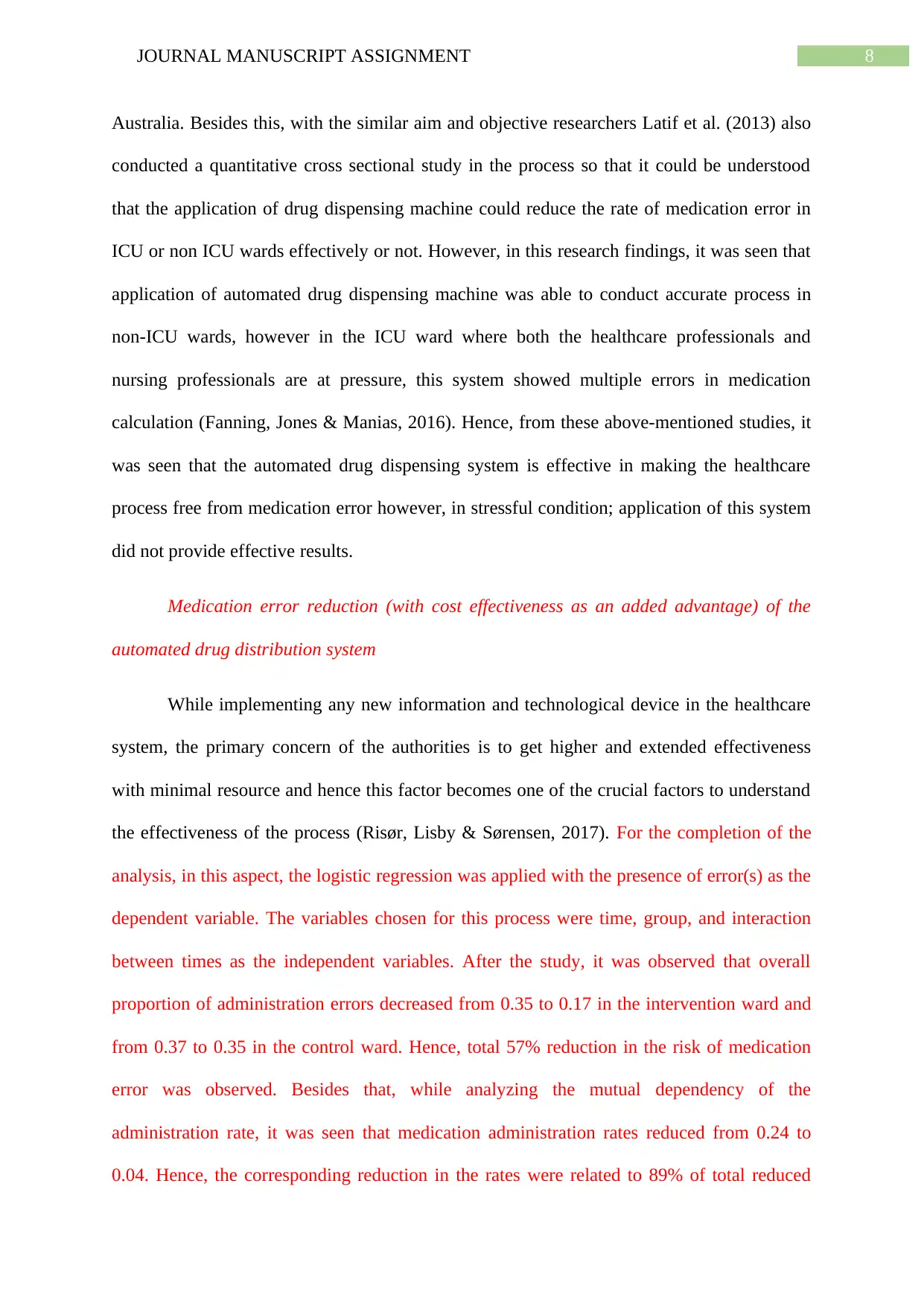
8JOURNAL MANUSCRIPT ASSIGNMENT
Australia. Besides this, with the similar aim and objective researchers Latif et al. (2013) also
conducted a quantitative cross sectional study in the process so that it could be understood
that the application of drug dispensing machine could reduce the rate of medication error in
ICU or non ICU wards effectively or not. However, in this research findings, it was seen that
application of automated drug dispensing machine was able to conduct accurate process in
non-ICU wards, however in the ICU ward where both the healthcare professionals and
nursing professionals are at pressure, this system showed multiple errors in medication
calculation (Fanning, Jones & Manias, 2016). Hence, from these above-mentioned studies, it
was seen that the automated drug dispensing system is effective in making the healthcare
process free from medication error however, in stressful condition; application of this system
did not provide effective results.
Medication error reduction (with cost effectiveness as an added advantage) of the
automated drug distribution system
While implementing any new information and technological device in the healthcare
system, the primary concern of the authorities is to get higher and extended effectiveness
with minimal resource and hence this factor becomes one of the crucial factors to understand
the effectiveness of the process (Risør, Lisby & Sørensen, 2017). For the completion of the
analysis, in this aspect, the logistic regression was applied with the presence of error(s) as the
dependent variable. The variables chosen for this process were time, group, and interaction
between times as the independent variables. After the study, it was observed that overall
proportion of administration errors decreased from 0.35 to 0.17 in the intervention ward and
from 0.37 to 0.35 in the control ward. Hence, total 57% reduction in the risk of medication
error was observed. Besides that, while analyzing the mutual dependency of the
administration rate, it was seen that medication administration rates reduced from 0.24 to
0.04. Hence, the corresponding reduction in the rates were related to 89% of total reduced
Australia. Besides this, with the similar aim and objective researchers Latif et al. (2013) also
conducted a quantitative cross sectional study in the process so that it could be understood
that the application of drug dispensing machine could reduce the rate of medication error in
ICU or non ICU wards effectively or not. However, in this research findings, it was seen that
application of automated drug dispensing machine was able to conduct accurate process in
non-ICU wards, however in the ICU ward where both the healthcare professionals and
nursing professionals are at pressure, this system showed multiple errors in medication
calculation (Fanning, Jones & Manias, 2016). Hence, from these above-mentioned studies, it
was seen that the automated drug dispensing system is effective in making the healthcare
process free from medication error however, in stressful condition; application of this system
did not provide effective results.
Medication error reduction (with cost effectiveness as an added advantage) of the
automated drug distribution system
While implementing any new information and technological device in the healthcare
system, the primary concern of the authorities is to get higher and extended effectiveness
with minimal resource and hence this factor becomes one of the crucial factors to understand
the effectiveness of the process (Risør, Lisby & Sørensen, 2017). For the completion of the
analysis, in this aspect, the logistic regression was applied with the presence of error(s) as the
dependent variable. The variables chosen for this process were time, group, and interaction
between times as the independent variables. After the study, it was observed that overall
proportion of administration errors decreased from 0.35 to 0.17 in the intervention ward and
from 0.37 to 0.35 in the control ward. Hence, total 57% reduction in the risk of medication
error was observed. Besides that, while analyzing the mutual dependency of the
administration rate, it was seen that medication administration rates reduced from 0.24 to
0.04. Hence, the corresponding reduction in the rates were related to 89% of total reduced
⊘ This is a preview!⊘
Do you want full access?
Subscribe today to unlock all pages.

Trusted by 1+ million students worldwide
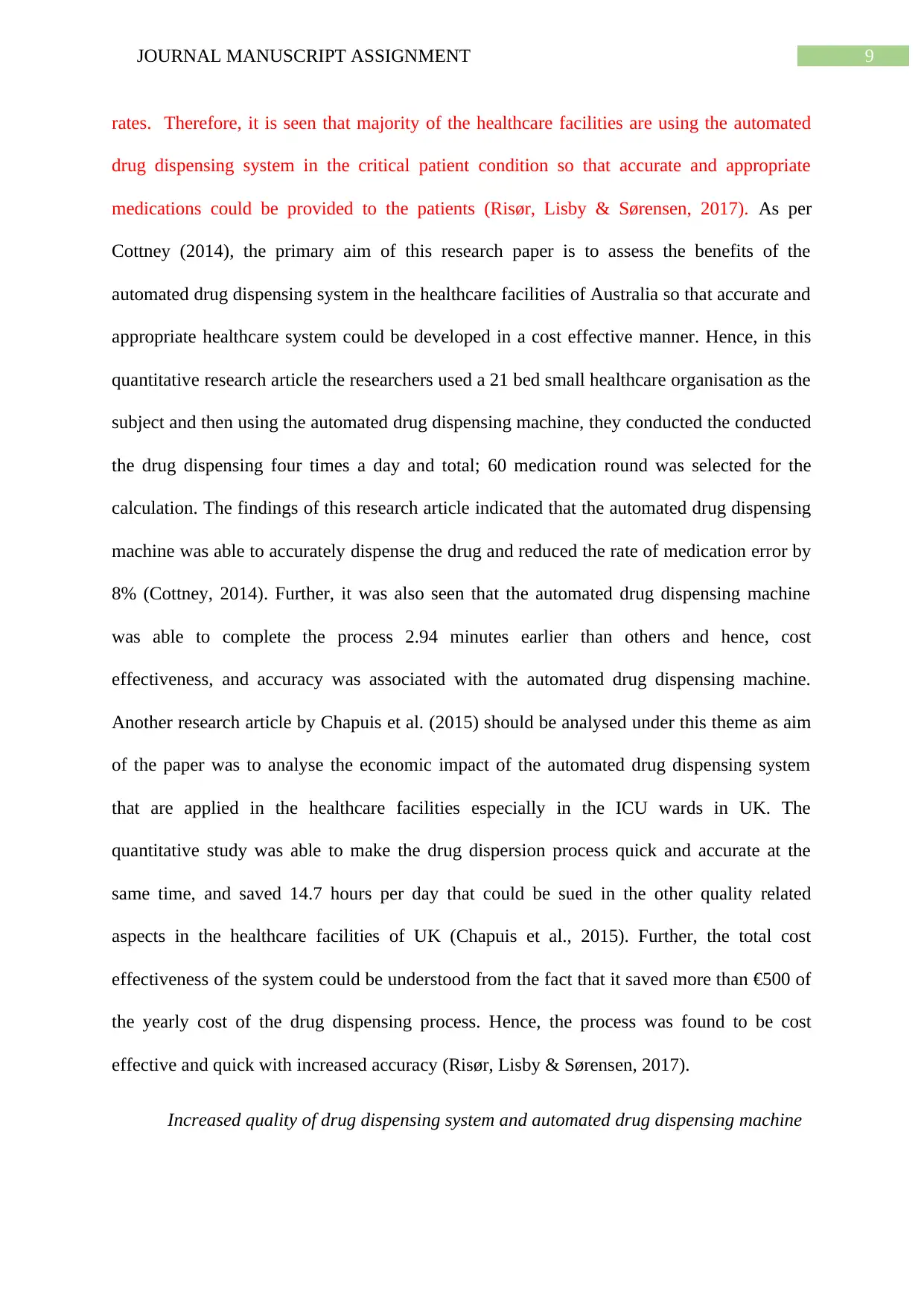
9JOURNAL MANUSCRIPT ASSIGNMENT
rates. Therefore, it is seen that majority of the healthcare facilities are using the automated
drug dispensing system in the critical patient condition so that accurate and appropriate
medications could be provided to the patients (Risør, Lisby & Sørensen, 2017). As per
Cottney (2014), the primary aim of this research paper is to assess the benefits of the
automated drug dispensing system in the healthcare facilities of Australia so that accurate and
appropriate healthcare system could be developed in a cost effective manner. Hence, in this
quantitative research article the researchers used a 21 bed small healthcare organisation as the
subject and then using the automated drug dispensing machine, they conducted the conducted
the drug dispensing four times a day and total; 60 medication round was selected for the
calculation. The findings of this research article indicated that the automated drug dispensing
machine was able to accurately dispense the drug and reduced the rate of medication error by
8% (Cottney, 2014). Further, it was also seen that the automated drug dispensing machine
was able to complete the process 2.94 minutes earlier than others and hence, cost
effectiveness, and accuracy was associated with the automated drug dispensing machine.
Another research article by Chapuis et al. (2015) should be analysed under this theme as aim
of the paper was to analyse the economic impact of the automated drug dispensing system
that are applied in the healthcare facilities especially in the ICU wards in UK. The
quantitative study was able to make the drug dispersion process quick and accurate at the
same time, and saved 14.7 hours per day that could be sued in the other quality related
aspects in the healthcare facilities of UK (Chapuis et al., 2015). Further, the total cost
effectiveness of the system could be understood from the fact that it saved more than €500 of
the yearly cost of the drug dispensing process. Hence, the process was found to be cost
effective and quick with increased accuracy (Risør, Lisby & Sørensen, 2017).
Increased quality of drug dispensing system and automated drug dispensing machine
rates. Therefore, it is seen that majority of the healthcare facilities are using the automated
drug dispensing system in the critical patient condition so that accurate and appropriate
medications could be provided to the patients (Risør, Lisby & Sørensen, 2017). As per
Cottney (2014), the primary aim of this research paper is to assess the benefits of the
automated drug dispensing system in the healthcare facilities of Australia so that accurate and
appropriate healthcare system could be developed in a cost effective manner. Hence, in this
quantitative research article the researchers used a 21 bed small healthcare organisation as the
subject and then using the automated drug dispensing machine, they conducted the conducted
the drug dispensing four times a day and total; 60 medication round was selected for the
calculation. The findings of this research article indicated that the automated drug dispensing
machine was able to accurately dispense the drug and reduced the rate of medication error by
8% (Cottney, 2014). Further, it was also seen that the automated drug dispensing machine
was able to complete the process 2.94 minutes earlier than others and hence, cost
effectiveness, and accuracy was associated with the automated drug dispensing machine.
Another research article by Chapuis et al. (2015) should be analysed under this theme as aim
of the paper was to analyse the economic impact of the automated drug dispensing system
that are applied in the healthcare facilities especially in the ICU wards in UK. The
quantitative study was able to make the drug dispersion process quick and accurate at the
same time, and saved 14.7 hours per day that could be sued in the other quality related
aspects in the healthcare facilities of UK (Chapuis et al., 2015). Further, the total cost
effectiveness of the system could be understood from the fact that it saved more than €500 of
the yearly cost of the drug dispensing process. Hence, the process was found to be cost
effective and quick with increased accuracy (Risør, Lisby & Sørensen, 2017).
Increased quality of drug dispensing system and automated drug dispensing machine
Paraphrase This Document
Need a fresh take? Get an instant paraphrase of this document with our AI Paraphraser
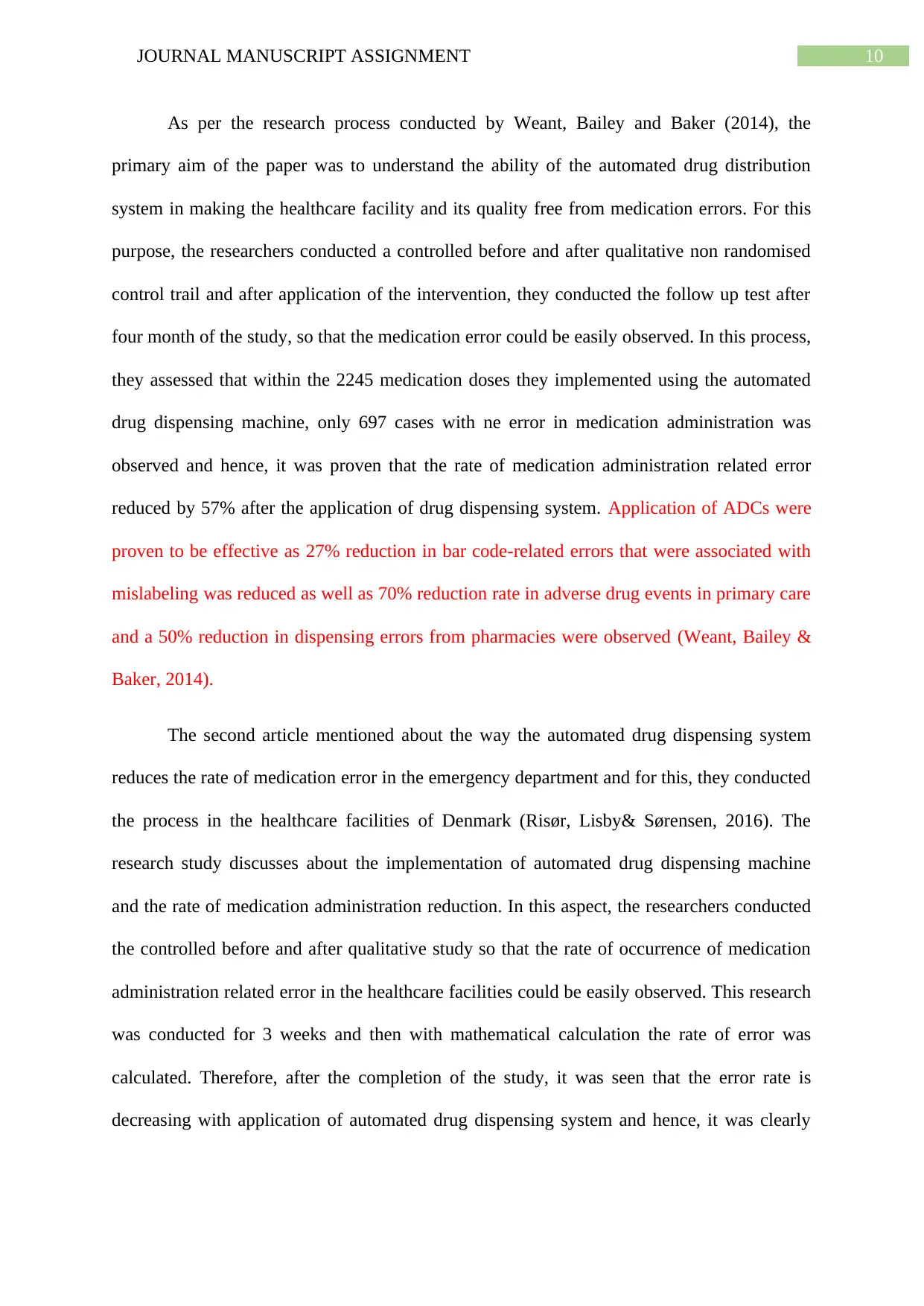
10JOURNAL MANUSCRIPT ASSIGNMENT
As per the research process conducted by Weant, Bailey and Baker (2014), the
primary aim of the paper was to understand the ability of the automated drug distribution
system in making the healthcare facility and its quality free from medication errors. For this
purpose, the researchers conducted a controlled before and after qualitative non randomised
control trail and after application of the intervention, they conducted the follow up test after
four month of the study, so that the medication error could be easily observed. In this process,
they assessed that within the 2245 medication doses they implemented using the automated
drug dispensing machine, only 697 cases with ne error in medication administration was
observed and hence, it was proven that the rate of medication administration related error
reduced by 57% after the application of drug dispensing system. Application of ADCs were
proven to be effective as 27% reduction in bar code-related errors that were associated with
mislabeling was reduced as well as 70% reduction rate in adverse drug events in primary care
and a 50% reduction in dispensing errors from pharmacies were observed (Weant, Bailey &
Baker, 2014).
The second article mentioned about the way the automated drug dispensing system
reduces the rate of medication error in the emergency department and for this, they conducted
the process in the healthcare facilities of Denmark (Risør, Lisby& Sørensen, 2016). The
research study discusses about the implementation of automated drug dispensing machine
and the rate of medication administration reduction. In this aspect, the researchers conducted
the controlled before and after qualitative study so that the rate of occurrence of medication
administration related error in the healthcare facilities could be easily observed. This research
was conducted for 3 weeks and then with mathematical calculation the rate of error was
calculated. Therefore, after the completion of the study, it was seen that the error rate is
decreasing with application of automated drug dispensing system and hence, it was clearly
As per the research process conducted by Weant, Bailey and Baker (2014), the
primary aim of the paper was to understand the ability of the automated drug distribution
system in making the healthcare facility and its quality free from medication errors. For this
purpose, the researchers conducted a controlled before and after qualitative non randomised
control trail and after application of the intervention, they conducted the follow up test after
four month of the study, so that the medication error could be easily observed. In this process,
they assessed that within the 2245 medication doses they implemented using the automated
drug dispensing machine, only 697 cases with ne error in medication administration was
observed and hence, it was proven that the rate of medication administration related error
reduced by 57% after the application of drug dispensing system. Application of ADCs were
proven to be effective as 27% reduction in bar code-related errors that were associated with
mislabeling was reduced as well as 70% reduction rate in adverse drug events in primary care
and a 50% reduction in dispensing errors from pharmacies were observed (Weant, Bailey &
Baker, 2014).
The second article mentioned about the way the automated drug dispensing system
reduces the rate of medication error in the emergency department and for this, they conducted
the process in the healthcare facilities of Denmark (Risør, Lisby& Sørensen, 2016). The
research study discusses about the implementation of automated drug dispensing machine
and the rate of medication administration reduction. In this aspect, the researchers conducted
the controlled before and after qualitative study so that the rate of occurrence of medication
administration related error in the healthcare facilities could be easily observed. This research
was conducted for 3 weeks and then with mathematical calculation the rate of error was
calculated. Therefore, after the completion of the study, it was seen that the error rate is
decreasing with application of automated drug dispensing system and hence, it was clearly

11JOURNAL MANUSCRIPT ASSIGNMENT
evident that application of drug dispensing system helps to increase the quality of medication
administration.
Similarly Cousein et al. (2014) conducted a research to understand the effectiveness
of this automated drug dispensing machine in reducing the rate of medication error and in this
qualitative before and after observational study they implemented two drug dispensing
machines such as the ward stock system and the Unit dose dispensing system which were
integrated with an automated medication dispensing cabinet. After completion of the study,
researchers found that the automated drug dispensing machine Unit dose dispensing system
was able to reduce the rate of medication error by 79% compared to the ward stock system
that reduced the rate of medication error by 53%. Therefore, all these studies indicated to the
fact that inclusion of drug distribution system is an effective way to reduce medication error
and enhance the quality of the healthcare process.
Discussion
This review was able to cover all the aspects related to the application of drug
distribution system to reduce the rate of medication error in healthcare facilities. All the
findings indicated to the fact that cost effectiveness of the automated drug dispensing
machine, its ability to increase the quality of medication administration and cost effectiveness
are the primary aspects that makes the healthcare facilities to implement this system.
Researches indicated that majority of the healthcare facilities are able to implement it because
of its limited maintenance and high quality services. Within Danish healthcare facilities, such
research work indicated more than 79% reduction of medication error. Hence, in the
discussion of the above-mentioned findings, it could be clearly stated that implementation of
automated drug dispensing machine in healthcare facilities not only helps to reduce the rate
of medication error but also reduces the cost if healthcare expenses.
evident that application of drug dispensing system helps to increase the quality of medication
administration.
Similarly Cousein et al. (2014) conducted a research to understand the effectiveness
of this automated drug dispensing machine in reducing the rate of medication error and in this
qualitative before and after observational study they implemented two drug dispensing
machines such as the ward stock system and the Unit dose dispensing system which were
integrated with an automated medication dispensing cabinet. After completion of the study,
researchers found that the automated drug dispensing machine Unit dose dispensing system
was able to reduce the rate of medication error by 79% compared to the ward stock system
that reduced the rate of medication error by 53%. Therefore, all these studies indicated to the
fact that inclusion of drug distribution system is an effective way to reduce medication error
and enhance the quality of the healthcare process.
Discussion
This review was able to cover all the aspects related to the application of drug
distribution system to reduce the rate of medication error in healthcare facilities. All the
findings indicated to the fact that cost effectiveness of the automated drug dispensing
machine, its ability to increase the quality of medication administration and cost effectiveness
are the primary aspects that makes the healthcare facilities to implement this system.
Researches indicated that majority of the healthcare facilities are able to implement it because
of its limited maintenance and high quality services. Within Danish healthcare facilities, such
research work indicated more than 79% reduction of medication error. Hence, in the
discussion of the above-mentioned findings, it could be clearly stated that implementation of
automated drug dispensing machine in healthcare facilities not only helps to reduce the rate
of medication error but also reduces the cost if healthcare expenses.
⊘ This is a preview!⊘
Do you want full access?
Subscribe today to unlock all pages.

Trusted by 1+ million students worldwide
1 out of 23
Related Documents
Your All-in-One AI-Powered Toolkit for Academic Success.
+13062052269
info@desklib.com
Available 24*7 on WhatsApp / Email
![[object Object]](/_next/static/media/star-bottom.7253800d.svg)
Unlock your academic potential
Copyright © 2020–2025 A2Z Services. All Rights Reserved. Developed and managed by ZUCOL.





